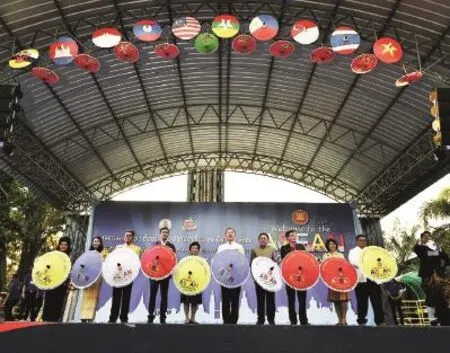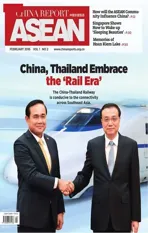How will the ASEAN Community Influence China?
2016-09-26
How will the ASEAN Community Influence China?

On November 22, 2015, leaders of 10 ASEAN countries posed for a group photo upon the signing of the ASEAN Community in Kuala Lumpur, Malaysia.
East Asia formed its first cross-nation union, the ASEAN Community, at the turn of the new year, which is expected to promote a new stage of integration and growth.
The 10 members of the Association of Southeast Asian Nations (ASEAN) now constitute a bloc of 600 million people sharing a political, security and economic roof.
With a total GDP of nearly US$2.6 trillion the seventh largest globally, the community aims to create a competitive single market with free fow of goods, services, investment capital and skilled labor. It is expected to grow into the world's fourth biggest economy by 2030, according to many analysts.
Infuence on China
The Chinese Foreign Ministry welcomed the establishment of the community, calling it a "signifcant milestone" in ASEAN integration.
"As a good friend and partner of ASEAN, China is confident of ASEAN's future development and wishes the ASEAN Community every success," the Ministry's spokesperson Lu Kang said at a press conference.
Despite skepticism of a true single economic entity, experts expect the community to bring China-ASEAN cooperation closer and promote regional integration as well as boost members' economic growth.
The community will certainly give im-petus to the upgrading of the ASEAN-China Free Trade Area (FTA) and the negotiation of the Regional Comprehensive Economic Partnership, said Wei Ling, Director of the Asian Studies Institute at the China Foreign Afairs University.
China has been ASEAN's largest trade partner, and the regional grouping has been China's third largest partner since the FTA was launched in 2010. The mutual trade volume was more than US$370 billion in the frst 10 months of 2015, and the annual trade is expected to reach US$1 trillion by 2020.
In December 2015, the two sides signed a protocol on deepened cooperation in bilateral trade. As a supplement to the original agreement of the ASEAN-China FTA,the protocol covers a wide range, such as trade in goods, services, investment and technological cooperation.
A unified and single ASEAN market will provide huge opportunities for China,Japan and the Republic of Korea, according to Wei. The community will optimize the layout of Asia's trade, finance and manufacturing industries, bringing good to the world as a whole.
Te community will better activate the implementation of Chinese initiatives such as the Belt and Road Initiative, which have good synergy with ASEAN's development and integration strategies.
ASEAN integration creates huge demand for transport and infrastructure improvement, which can be met by China,with its abundant funds and technologies,said Wei.
The Belt and Road Initiative could help promote ASEAN's development by improving infrastructure throughout the region both on land and at sea, said Kavi Chongkittavorn, senior fellow at the Institute of Security and International Studies at Chulalongkorn University of Tailand.
China has also set up the Silk Road Fund and spearheaded the establishment of the Asian Infrastructure Investment Bank(AIIB), both expected to finance many connectivity projects.
There is a general consensus that ASEAN nations will undoubtedly unify some economic policies within the community and objectively reduce barriers for the entry of Chinese investment.
Under the Belt and Road Initiative and the support of AIIB, Wei forecast a new wave of growth of China's industrial investment in ASEAN States.
Te merger could also help the Chinese Yuan flow into the region, according to Professor Zhou Yongsheng, an expert in international relations at the China Foreign Afairs University.
The community will optimize the layout of Asia's trade,finance and manufacturing industries, bringing good to the world as a whole.

An event “ASEAN Cultural Festival:Into ASEAN Community” , sponsored by the Public Relations Department of Kingdom of Thailand, was held in Bangkok from December 24 to 26,2105. Through cultural exhibition, the event demonstrates the cultural diversity of ten ASEAN member states so to welcome the foundation of the ASEAN Community at the end of 2015.
Strong Supporter
China said it will continue to firmly support ASEAN's integration, and is willing to make joint efforts to build a more closely-related Community of Common Destiny for both sides.
Yet, despite a high-degree of inter-dependence within the community, obstacles still remain to complete integration.
ASEAN is perhaps one of the most diverse regional groupings in the world,in terms of both economic development and political, ethnic, religious and cultural backgrounds.
Tere is a conspicuous divide between the six older and richer ASEAN members such as Singapore and four newer and poorer members, namely, Cambodia, Laos,Myanmar and Vietnam.
Chen Qiye, associate professor at the Lee Kuan Yew School of Public Policy in Singapore, sees a good chance for China to advocate the Belt and Road initiative,helping narrow development gaps for integration while optimizing its own economic structure.
Seizing the opportunity of the 25th anniversary for the establishment of the China-ASEAN dialogue in 2016, experts suggest China should expand mutual political trust by signing a series of friendly and cooperation treaties with the group.
China is expected to take the lead to push for more cooperation mechanisms with the community and provide more public service goods for innovation in the work of anti-terrorism, environmental protection and health care, according to global strategy researcher Zhou Fangye.
China should also continue to promote peaceful bilateral negotiations with related parties concerning South China Sea issues and seek to maintain regional stability and development, said Zhou Yongsheng.
(Source: Xinhua News Agency)
